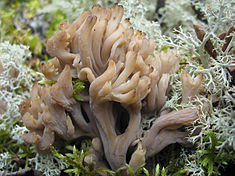- Clavulina cristata
-
Clavulina cristata Scientific classification Kingdom: Fungi Division: Basidiomycota Class: Agaricomycetes Order: Gomphales Family: Clavulinaceae Genus: Clavulina Species: C. cristata Binomial name Clavulina cristata
(Holmsk.) J. Schröt.Synonyms Clavulina coralloides (L.) J. Schröt.
Clavulina cristata Mycological characteristics 
smooth hymenium 
no distinct cap 
stipe is bare 
spore print is white 

ecology is saprotrophic
or mycorrhizal
edibility: edible Clavulina cristata, commonly known as the white coral fungus or the crested coral fungus,[1] is a white- or light-colored edible coral mushroom present in temperate areas of the Americas and Europe. It is the type species of the genus Clavulina.
The commonly used species name cristata was coined in 1790 by Danish mycologist Theodor Holmskjold (as Ramaria cristata). However, Linnaeus described apparently the same fungus as Clavaria coralloides in Species plantarum in 1753.[2] Therefore according to the International Code of Botanical Nomenclature (which also applies to fungi), the name Clavulina coralloides should be used in preference to Clavulina cristata,[3][4] although the latter name is in more common use.
Contents
Description
Fruit bodies, which are generally white- to cream-colored, can be up to 8 centimetres (3.1 in) tall, and 2–4 cm (0.8–1.6 in) broad. The coral "arms" are sparingly branched (3–4 times), 2–4 mm wide,[5] smooth, and sometimes wrinkled longitudinally. The tips are cristate, having small pointed projections, and will often darken with age or in dry weather.[6] The fruit bodies have no distinctive odor, and a mild taste.[5]
The fruit bodies may have a darker color either due to natural variation (whereby the appearance of this species may approach and be confused with C. cinerea) or because of infection by a microscopic fungus, Helminthosphaeria clavariarum.[4]
Microscopic features
The spores are white, roughly spherical, thick-walled, non-amyloid, smooth, and have dimensions of 7–11 by 6–10 µm.[5][7] Basidia are club-shaped, 60–80 by 6–8 µm, and 2-spored.[1] Cystidia are absent. Sterigmata, the slender projections of the basidium that bear the spores, may be straight or curved, and up to 7–8 µm long.[8]
 Spores
Spores
Habitat
Clavulina cristata is found growing solitary or in clusters on the ground (sometimes on rotten wood) in both coniferous and hardwood forests. It is a common mushroom, and typically fruits from late summer to winter.
Edibility
This fungus is edible,[9][10] but the tough flesh and insubstantial fruit bodies make it unappetizing for most individuals.[7]
Lookalikes
Several other coral fungi have overall appearances similar to Clavulina cristata, making identification confusing. Clavulina rugosa is unbranched or sparingly branched. Clavulina cinerea is usually darker in color. Ramaria stricta has parallel branches and grows on wood..
Chemistry
In addition to the major fatty acid components, palmitic acid, oleic acid and linoleic acid, C. cristata contains two unusual fatty acids, cis-9, cis-14-octadecadien-12-ynoic acid, and the conjugated cis-9, trans-11, trans-13, cis-15-octadecatetraenoic acid (commonly known as α-parinaric acid).[11] C. cristata is the only fungi known to contain α-parinaric acid.[12]
References
- ^ a b Ellis, J. B.; Ellis, Martin B. (1990). Fungi without gills (hymenomycetes and gasteromycetes): an identification handbook. London: Chapman and Hall. p. 66. ISBN 0-412-36970-2.
- ^ See bottom of p. 1182 of Carolus Linnaeus "Species Plantarum, exhibentes ..." (1753), available on-line at the Missouri Botanical Garden's digital library.
- ^ See the Index Fungorum entry.
- ^ a b See Kuo, M. (2007, April) the MushroomExpert.Com Web site entry: [1].
- ^ a b c Miller, Hope Ridings; Miller, Orson K. (2006). North American mushrooms: a field guide to edible and inedible fungi. Guilford, Conn: Falcon Guide. p. 345. ISBN 0-7627-3109-5.
- ^ Arora, David (1986). Mushrooms Demystified: A Comprehensive Guide to the Fleshy Fungi. Berkeley, Calif: Ten Speed Press. ISBN 0-89815-169-4.Google Books
- ^ a b Orr, Dorothy B.; Orr, Robert Thomas (1980). Mushrooms of Western North America (California Natural History Guides). Berkeley: University of California Press. p. 65. ISBN 0-520-03660-3.
- ^ Linda Fung-yee Ng (1993). The Macrofungus Flora of China's Guangdong Province (Chinese University Press). New York: Columbia University Press. p. 93. ISBN 962-201-556-5. Google Books
- ^ Foy, Nicky; Phillips, Roger; Kibby, Geoffrey (1991). Mushrooms of North America. Boston: Little, Brown. p. 292. ISBN 0-316-70613-2.
- ^ Ian Burrows (2005). Food from the Wild. New Holland Publishers Ltd. p. 98. ISBN 1-84330-891-6. Google Books
- ^ Endo S, Zhiping G, Takagi T. (1991). Lipid components of seven species of Basidiomycotina and three species of Ascomycotina. Journal of the Japan Oil Chemists' Society 40(7): 574–77.
- ^ Endo S. (1997). Vegetables are a treasurehouse of effective lipid sources. Nihon yukagaku kaishi 46(10): 1247–256. Abstract
External links
Categories:- Fungi of Europe
- Fungi of Chile
- Fungi of North America
- Edible fungi
- Agaricomycetes
Wikimedia Foundation. 2010.

